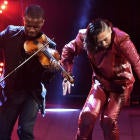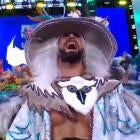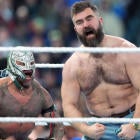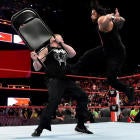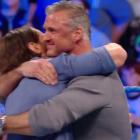From his iconic ring entrance to his physical, mixed martial arts-inspired striking that helped back up his claim as the âKing of Strong Style,â Shinsuke Nakamura has proven throughout his first 12 months with WWE that thereâs an equal amount of substance to match his flashy style.
But make no mistake about it, Nakamura, 37, loves being all about style.
From the flashing lights and pulsating dance moves that make up his entrance to his hypnotic theme song, Nakamura has made it a habit of grapping your attention from the moment you first see him and never letting go. As far as sports entertainment is concerned, the native of Japan is unique -- and he knows it.
âHow important [is the ring entrance]? Maybe 90 percent,â Nakamura told CBS Sports. âEvery characteristic of my character and my moves always came from my real life. My character is kind of close to my real personality. Iâm just enjoying my life. Iâm using the desire.â
If It feels like Nakamura is having more fun inside the ring than anyone else, thatâs by design.
Nakamura, who left New Japan Pro Wrestling after a distinguished 14-year career, will celebrate his one-year anniversary with WWE on Saturday when he headlines NXT TakeOver: Orlando against Bobby Roode, the current NXT champion, on the night before WrestleMania 33.
After losing his title to Roode at NXT TakeOver: San Antonio in January, Nakamura appeared poised to make his main roster debut. Most believe Saturday will be his last NXT match, just one year after he made a splash by defeating Sami Zayn in his debut at NXT TakeOver: Dallas during WrestleMania 32 weekend in a bout hailed as one of 2016âs best.
With a background in classic ballet, yoga and MMA, everything Nakamura does looks and feels different. Thereâs almost a competing element to his movements that at one second resemble the effeminate beauty of a dancer before instantly giving way to the brutality of an MMA-inspired knee strike.
Nakamura often contorts his fingers into creepy patterns of movement and thrusts his pelvis in ways that can be perceived as provocative, further adding to the mystery of his characterâs mindset. His influences come directly from Western popular culture, including the movements of Michael Jackson and the charisma of Queen frontman Freddie Mercury.
âSo Michael Jackson, his moving looks like a martial artist moving,â Nakamura said. âHeâs quicker than other dancers but he donât have muscles. Most dancers have huge muscles. So his dancing is quicker than everybody. He looks [like heâs] controlling gravity. He looks like an oriental martial arts master. I tried to steal a body movement from him. So thatâs why I imitate Michael Jackson a little bit.â
Nakamura said that he never gets nervous before a match and remains calm to save his energy ... but the second he hears his theme song kick in ... âI start. I become ready to wrestle.â
It took a little bit of time, however, for Nakamura to sign off on a WWE theme song that made him feel whole.
âBefore I debuted, WWE sent me the sample of music,â he said. âSo I kicked it out. âI donât use this, I donât need this.â They tried to keep saying, âPlease use this. Please use this.â I said, âNo, no, no.â Finally, I asked them, âPlease use violin.ââ
After Nakamura sent some samples and a further back and forth ensued, the eventual result was âRising Sun,â produced by CFO$, which instantly became one of WWEâs most downloaded songs on iTunes. The song has also helped Nakamura produce the kind of unforgettable entrances that have, at times, become more talked about than his actual matches.
Nakamuraâs favorite entrance to date came last August during SummerSlam weekend in Brooklyn, New York, when he was joined by one of the worldâs best violinists, Lee England Jr., who performed a live version of his theme song.
âThat entrance was very good for my career,â said Nakamura. âIt showed my desire, my drive and the stuff [deep inside] from the basement in that entrance.â
Nakamuraâs entrance had such an impact on the Barclays Center crowd that night that fans left the arena -- shortly after Nakamura defeated Samoa Joe in the main event to win the NXT title -- still chanting the melody to his theme song in unison.
âSo my friend came from Brooklyn and told me later that after the match, on the street, even in the subway, still everybody was singing,â Nakamura said. âThat was awesome.â
The Nakamura sing along is real...even in the hallways of the Barclays Center. #NXTTakeOverpic.twitter.com/1O6gEtf5Yu
— Randy Cruz (@randyjcruz) August 21, 2016
While Nakamura has worked hard to learn and incorporate English into his promos and interviews, he admits he still has a long way to go. It hasnât hampered him much, though, because of the nonverbal chemistry he has with the crowd.
From Nakamuraâs perspective, wrestling is just another expression of art.
âEvery culture has music and dancing and fighting,â Nakamura said. âThatâs my basic [elements of art]. If I think about [my] art, itâs wrestling, so I can connect everybody.â
Part of that connection has come through the âstrong styleâ he brought over from Japan, which is typically a more stiff working style than seen in the United States. But thatâs not always the case for Nakamura.
One of the secrets to his artistry is the fact he doesnât always have to use more force to make you believe heâs doing so. Itâs something he calls âmadness as the motion,â which he learned from Japanese legend Antonio Inoki.
âAntonio Inoki majored in strong style,â Nakamura said. âHe showed real emotion with real technique in the ring. Hard shots that look like hard shots. But the important steps is the real technique from the real martial arts. It means detail is important.â
Having a finishing move that looked real was important to Nakamura, which is why he began using his running knee to the face, which he calls âKinsasha.â He began utilizing it in 2008, knowing firsthand how damaging the move can be after years of training MMA.
Nakamuraâs most vicious âKinsashaâ to date may have come against Samoa Joe at NXT TakeOver: Brooklyn II. It resulted in a dislocated jaw for Joe, and Nakamura admits he struck him harder than he intended to but wanted to make it look real.
âYes, because Samoa Joe is like a huge tree,â he said, âso I need to hit him harder and harder.â
Nakamura didnât grow up watching WWE in Japan and never thought he would wrestle with the company until something changed in his mind while working for New Japan in 2006.
âI wanted to see, I wanted to change something,â Nakamura said. âI wanted to be bigger and wanted to change the world and my world. The match [last year] at TakeOver: Dallas, I faced Sami Zayn and that match did huge things for me. I want [to provide] inspiration for the people to follow what they want.â
Nakamura knows his time is somewhat limited as a WWE rookie whoâs closing in on 40. But it has made him focus even harder on achieving his goals, which include using a full orchestra for his entrance during his main roster debut and, of course, competing at WrestleMania and winning a championship.
Asked which brand, Raw or SmackDown, he would prefer, Nakamura calmly said both.
âI want to be on SmackDown because it has AJ Styles, Randy Orton and John Cena -- a lot of dream matches I can do,â Nakamura said. âAlso, Monday Night Raw has a lot of friends there [who previously wrestled in Japan] like Finn Balor, Samoa Joe, [Luke] Gallows and [Karl] Anderson, which would be much comfortable for me. But first I need to concentrate for TakeOver: Orlando now and Bobby Roode.â












